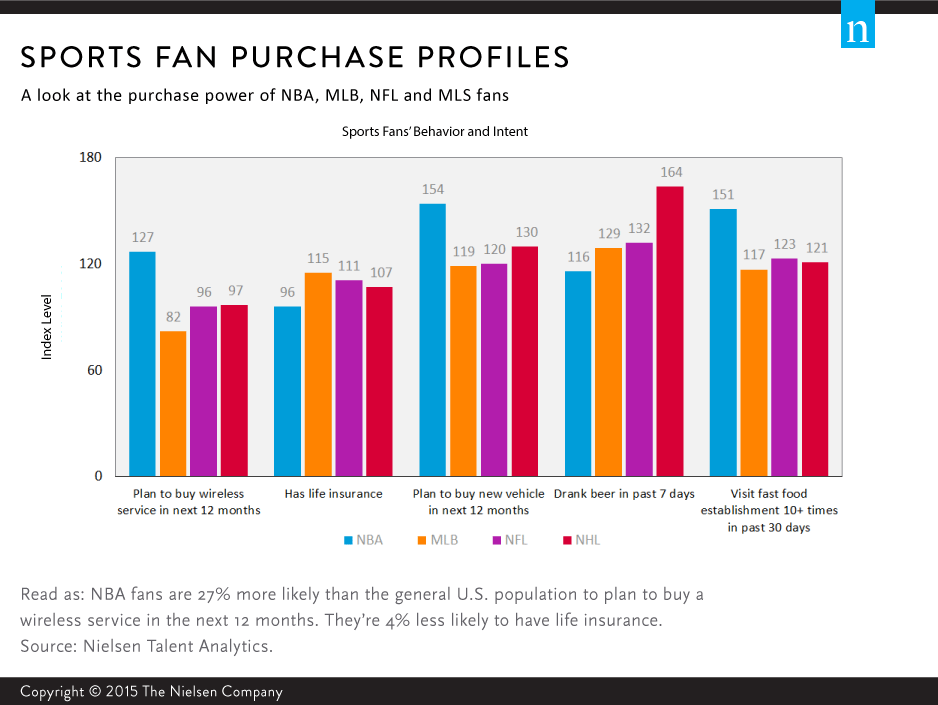The highly anticipated 2015 NBA finals are underway, featuring current league MVP Stephen Curry leading the Golden State Warriors against four-time MVP LeBron James and the Cleveland Cavaliers. Both players are big stars with multiple endorsement deals under their belts and already draw the attention of the masses. So while the battle on the court should be a thriller, with shots raining from both sides, advertisers are hoping fans will be inspired to make it rain too—by spending big at the checkout counter.
With a stat sheet and highlight reel like James’ or Curry’s, it’s understandable why an advertiser would jump at the chance to have either of them lend their name to a product. In fact, according to Nielsen’s N-Score, the majority of people who know them view them as successful, at 65% and 53% for James and Curry, respectively. Having a big-name endorser can certainly up a brand’s “cool factor” or help make it stand out in the minds of consumers, but the real question is: Does that star spokesperson actually drive sales?
“The value that a star athlete like James or Curry can bring to a brand is undeniable. But proving the actual ROI of that relationship and truly maximizing that investment is still somewhat of a challenge for marketers,” said Stephen Master, Nielsen’s global SVP of sports. “Having a deep understanding of an athlete’s fans—what they’re actually watching, buying and listening to—means having the ability to make smarter marketing decisions.”
With that in mind, a Nielsen Talent Analytics study set out to assess fans of both James and Curry, looking at how they compare to the general U.S. population in purchases of select items that each player endorses. Fans of LeBron James are likely to be in the market for a new wireless service, as they’re 30% more likely than the average American to report planning to switch mobile carriers in the next 12 months. They’re also prospective car owners, 5% more likely to plan to buy a luxury vehicle in the next 12 months and 26% more likely to be on the hunt for a full-size car. Curry’s fans are more likely than the general population to purchase deodorant (16% more likely) and athletic and men’s business clothing, 18% and 14% more likely, respectively.
Fan Purchase Profile
Select Product Categories Endorsed by Each Player
|
|
|
||
| Purchase | Index vs. Gen U.S. Pop | Purchase | Index vs. Gen U.S. Pop |
| Plans to Buy a Luxury Vehicle | 105 | Bought Deodorant | 116 |
| Plans to Buy a Full-Size Car | 126 | Bought Any Athletic Clothing | 118 |
| Owns a Smartphone Running Android OS | 126 | Bought Any Athletic Shoe | 105 |
| Plans to Switch Wireless Carrier in Next 12 Months | 130 | Purchased Men’s Business Clothing in Last 12 Months | 114 |
| Visited Fast Food Restaurant 10+ Times in Last 30 Days | 114 | Purchased Men’s Casual Clothing in Last 12 Months | 101 |
| Purchased Any Carbonated Beverage | 97 | Has Life Insurance | 75 |
| Read as: Fans of LeBron James are 5% more likely than the general U.S. population to plan to buy a luxury vehicle in the next 12 months. Source: Nielsen Talent Analytics |
But it’s not just James’ and Curry’s fans who wield the purchase power that advertisers dream of. As a group, sports fans are avid consumers of some of the most commonly advertised products in sports. They also present an excellent opportunity for future engagement. For instance, NBA fans are 54% more likely than the general U.S. population to plan to buy a new vehicle in the next 12 months—more likely than fans of the other major sports leagues. They’re also the most likely to be frequent fast food goers and are 51% more likely than the general U.S. population to have visited a fast food establishment more than 10 times in the past 30 days.
On the other hand, NBA fans present a valuable opportunity for insurance advertisers, for example, as they’re 4% less likely to have life insurance than the general population.

Methodology
Nielsen Talent Analytics is the collective Nielsen intelligence, insights and solutions for linking brands and audiences to entertainment personalities. Nielsen N-Score survey data were used to create a profile of each player’s “fans” – defined as those who were aware of the player and reported that they “like” the player or “like a lot.” That profile was then linked to Nielsen’s HomeScan, Nielsen Scarborough and Nielsen SLMS solutions to glean insights on those fans’ actual and reported purchases, as well as their behaviors and intent.



